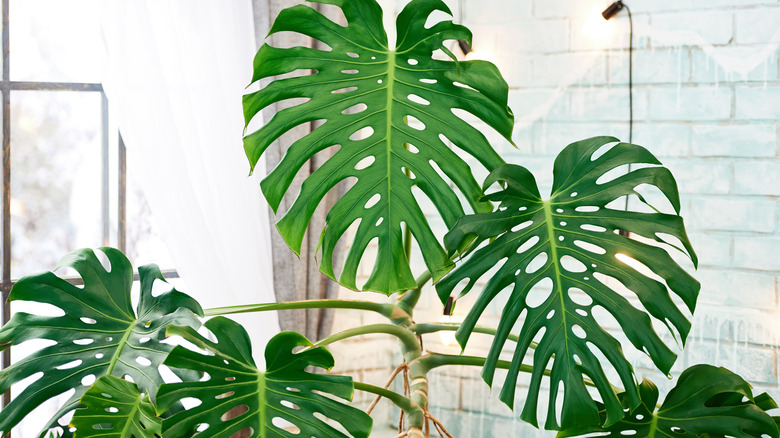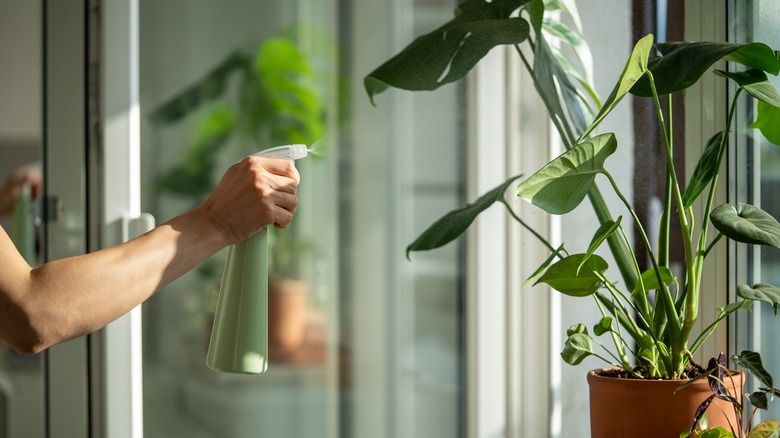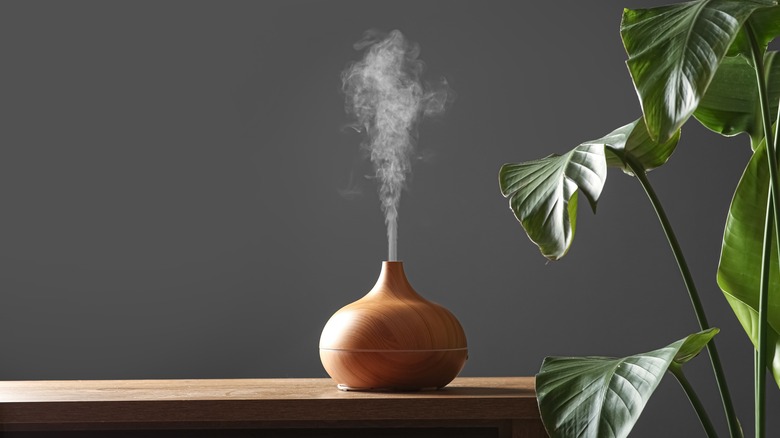This Is The Secret To Keeping Your Monstera Deliciosa Happy And Healthy
Monstera deliciosa, also known as the Swiss cheese plant, is a popular tropical houseplant. It is characterized by its large, glossy, and fenestrated leaves, which have distinctive holes and splits as the plant matures. Monstera deliciosa is known for its vigorous growth, climbing habit, and ability to thrive in low light conditions. Monsteras benefit from a humid environment because they are native to tropical rainforests. In their natural habitat, they're exposed to high levels of moisture in the air, keeping their leaves hydrated and preventing them from drying out. One way that you can keep your monstera happy in your home is by misting it to increase the humidity.
Humidity is important for plants because it helps to regulate their transpiration process—the process by which plants release moisture through their leaves. In high humidity environments, the rate of transpiration is slower, which means that the plant retains more moisture and is less likely to become dehydrated. In addition to preventing dehydration, humidity also promotes healthy growth for monsteras. High humidity levels provide the ideal conditions for the plant to absorb nutrients and water from the soil, which is essential for their overall health and development. Furthermore, a humid environment helps to prevent the leaves of the monstera from becoming crispy or developing brown edges. When the air is dry, the moisture in the leaves evaporates quickly, leading to leaf damage. Therefore, misting a monstera can allow it to thrive.
How and when to mist your monstera deliciosa
To elevate the humidity for a monstera deliciosa, misting is a popular method that can be effective when done correctly. It involves spraying a fine mist of water onto the leaves of the plant, which helps to increase the humidity in the immediate vicinity. The best time to mist a plant is in the morning, as this allows the leaves to dry off and cool during the day.
Misting should be done when the humidity levels are low or when the plant looks dehydrated, indicated by drooping leaves or dry soil. However, it is important not to over-mist the plant, as excessive moisture can lead to fungal growth and other issues. A general guideline is to mist your plant a few times per week, but this can vary depending on the specific conditions of your home and the season. Typically, plants will need more misting in the cool, dryer seasons than in the warm, wet summers.
When misting the plant, use room temperature water to avoid shocking the plant. It is also recommended to use a spray bottle with a fine mist setting to ensure that the water droplets are small and evenly distributed. When misting, make sure to cover both sides of the leaves, as this is where the plant absorbs moisture. By developing a misting routine, you can ensure that your plants stay hydrated throughout the dryer months.
Other ways to increase humidity for your plants
Raising humidity in your home for indoor tropical plants is crucial for their overall health and well-being. While misting is a popular method, there are other effective ways to increase humidity. One way is by using a humidifier. Humidifiers release moisture into the air, creating a more humid environment for plants. It also promotes healthy growth and prevents the plant from becoming stressed or susceptible to pests like spider mites.
Another way to increase humidity for indoor tropical plants is by grouping them together. When plants are grouped closely, they create a microclimate with higher humidity levels. This is beneficial because plants release moisture through a process called transpiration. When plants are grouped together, the moisture released by one plant is absorbed by the surrounding plants, creating a more humid environment. Grouping plants also helps to create a visually appealing display and can make caring for multiple plants more convenient.
A third way to increase humidity for indoor tropical plants is by using a pebble tray. A pebble tray is a shallow tray filled with water and pebbles. The plants are placed on top of the pebbles, and as the water evaporates, it increases the humidity around the plants. This method is beneficial because it provides a localized increase in humidity, which is especially useful for plants that require higher humidity levels. Additionally, the pebbles prevent the plants from sitting in water, preventing root rot and other moisture-related issues.


